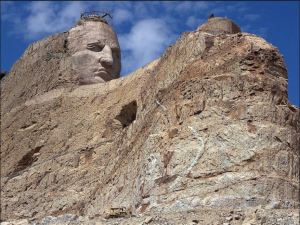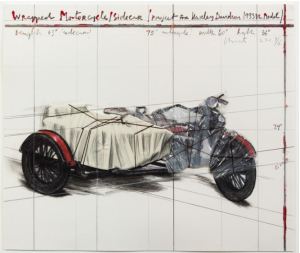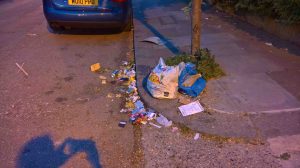Post Studio Art
Monumental Art
In 2009 in Essex a White horse 50m high designed by Mark Wallinger was chosen as an iconic emblem for Ebbsfleet, the gateway to Europe. There are mock ups and virtual reality pieces, but still no white horse, the project has been defeated by lack of finance.
There is another aspect to this also, what does a painting of a horse signify? According to the Independent Whistlejacket by Stubbs is “a paradigm of the flawless beauty of an Arabian thoroughbred” whereas Race Class and Sex by Wallinger “depicts that the aristocracy is so interested in breeding.” They are both paintings of racehorses. in fact, both very fine paintings of racehorses, so why the distinction. When you interact with a piece of art, that is exactly what you do, it is a very personal thing, to be swayed by the comments of the critics or throwaway comments by the artist is not part of the interaction. If the artist has something to say, unless he can say it on the canvas he should remain mute. There is a quote by Dorothea Tanning “Come lets go into the studio, I’ll show you some new pictures, but please don’t ask me to explain, I just don’t think it is possible, I paint, I can only describe this as a dry”. Perhaps the fact that the Stubbs painting has been preserved over the centuries is some kind of indication that the upper classes are interested in horse breeding to produce the perfect horse, but for me Wallinger’s insinuation does not add up. I am not aristocracy but I do like looking at racehorses at the track and great paintings of racehorses they are both a thing of beauty if I was interested instead in breeding, I would be watching a whole other part of the internet. To put it another way Degas said “A painting requires a little mystery, some vagueness, and some fantasy. When you always make your meaning perfectly plain you end up boring people.”

Figure 1 Virtual mock up of the Essex horse
In 1482 Leonardo da Vinci was commissioned by the Duke of Milan to create the world’s largest bronze horse. The clay prototype was destroyed by the invading French army in 1499. There are Leonardo’s sketches but no bronze horse, the technology to cast such a large bronze statue was problematical and the project was eventually defeated by the invading French.

Figure 2 Leonardo da Vinci studies for a horse
Interestingly there is a postscript to the Leonardo story. In 1999 the sculptress Nina Akamu working from Leonardo’s drawings and ideas after a 22 year fundraising campaign created two seven meter High Bronze horses, one of which stands in Milan and the other in Grand Rapids Michigan.

Figure 3 Nina Akamu 7 meter high Bronze Horse after Leonardo da Vinci, San Siro Hippodrome, Milan
There is another horse sculpture, as yet incomplete, of Red Indian Chief Crazy Horse, mounted on his horse that since 1948 is being carved out of a mountain in South Dakota.

Figure 4 Crazy Horse Memorial, South Dakota
The three examples above are a perfect illustration of the time and money and politics involved in colossal undertakings of this this type of Post Studio Art.
This type of art has its origins in the ancient world, the Sphinx and the Pyramids and Stonehenge come readily to mind. In a similar way that the Pharaoh’s engaged their subjects to construct pyramids, the Catholic Church created the great cathedrals, the Empires created great monuments to themselves or their leaders and of course with more recent art museums it has often been evident that the main exhibit is the building’s own exterior (Bell p176) These undertakings invariably used vast armies of labour, craftsmen and technicians in their creation even Michelangelo’s David had been worked on by previous sculptors and had to be moved into position by labour and its position had to be decided by committee as it was too heavy to be mounted in its intended position on the cathedral.
These vast projects all have a wow factor as pieces of art engineering and tourism and are to the glory of man, their Gods or their leaders and all dominate their immediate environment.
Christo and Jeanne Claude
Christo and Jeanne Claude made plans and sketches to wrap the Arc de Triomphe in 1962 and although the plans and sketches are on their web site it is another project that has yet to come to fruition and has probably lost some of its novelty value as Christo and Jeanne Claude have actually wrapped the Reichstag and Pont Neuf

Figure 5 Wrapped Motorcycle Project for Harley Davidson (1997) Christo and Jeanne Claude
At the London Print Fair I saw a limited edition lithograph print with added collage of Wrapped Motorcycle Project for Harley Davidson (1997) There was no photograph on the internet of the actual wrapped Harley Davidson, so maybe the project was rejected by the Harley Davidson Marketing Department.

Figure 6 Wrapped motorcycle 1962 Christo and Jeanne Claude
There is, however, a photograph of the wrapped motorcycle of 1962 that Christo and Jeanne Claude did in 1962 before they started wrapping buildings, which probably in some way inspired the Harley Davidson Project. Even though the Harley Davidson may not have been wrapped, the print brings to life, the images that are on the internet for the wrapped Arc de Triumph. It is surprising that given the obvious artistic talents that is evident in the print I saw, that the only records of their finished pieces are photographic, this could be down to the trend that it is considered normal for a happening to be covered by the media in photography and film or that the wrapped object is the art and as such is there to be photographed as any gallery exhibit.

Figure 7 The Gates Project, Central Park, New York, 2005. Christo and Jeanne Claude
The Gates Project in Central park was planned from 1979 and was only realised in 2005 for 16 days. Strictly speaking this work was a collaboration not only between Christo and Jeanne Claude but also with Fredrick Law Olmstead and Calvert Vaux, the designers of Central Park, itself an entirely man made work of art, (Findlay P129) and of course the construction workers, craftsmen and technicians that worked on both projects.
Wrapping of things has a big tradition in Art History, from Pre-Renaissance times. It was standard practice for artists to do studies of the draperies used to clothe their anatomically correct naked models. Centuries before the idea of abstract art had even been dreamed of, the flow and the rhythm of drapery, its twists of form and its sudden explosions of colour, offered figurative painters expressive possibilities closely akin to those promised by abstraction. Look at how an artist paints drapery and you often see, in its purest state, how they use form and colour to express the emotions that lie at the heart of their work. (Graham Dixon, A.)
There is also the famous work by Il Braghettone (the Breeches maker) Daniele da Voltera, the painter of the loincloths on Michelangelo’s The Last Judgement in the Sistine Chapel. From the tablecloths of the Dutch Vanitas Artists to the drapes and tablecloths of Cezanne the wrapping tradition continued and Duchamp wrapped miniatures of his paintings in a suitcase.
Jessica Stockwell was invited to create on State Street Chicago, more than anything it is big, bigger being better seems to be a good thing in this type of Post Studio Art together with a healthy dose of government involvement, local or national, which seems necessary. While it is fashionable these days to have clean uncluttered look to architecture and statuary, in former times both were painted and this project harks back to those ancient times
Consider who on Chicago City Council gets the accolade for turning the river green on St Patrick’s Day, which also brings up the thorny problem of who is the creator of a work of art. If you decide to have your portrait painted, and engage an artist to do so, is the artist part of the team in realising your vision? Or does the artist create the perfect impression of your vision in his portrait? It becomes more interesting if you insert real names into the problem “I, Francesco di Bartolomeo di Zanobi del Giocondo, would like you, Signore da Vinci to paint a portrait of my wife that would exemplify my love for my Lisa and her cute little smile.”
The undercover way
The alternative is to go completely anti-establishment and make your art in the dead of night when no one is watching, not even a CCTV camera, and you can create works of art on the wall of a cave that does not actually belong to you. The mysterious nature of the creator adds celebrity cult to the reportage.

Figure 8 Banksy meets an original New York graffiti artist in a cave in the Barbican London
You could of course be much less famous and express yourself equally vociferously, although your installation would be much more temporary and would incur the wrath of the City Council who are of course proud on the other hand of promoting installation art, but only so, if it costs lots of money.

Figure 9 Installation piece, anonymous artist.
Another method of expression is to spit your chewed gum onto the pavement for the council to remove at their convenience. In two London boroughs Muswell Hill and Southwark artists have taken to decorating the spent gum with miniature works of art.

Figure 10 Gum art, Millennium Bridge, Southwark
When I was crossing the Millennium Bridge at the weekend, the City Council were in the process of removing the waste gum but it was leaving behind traces of the paint that the gum artists had used on the metal of the bridge structure. There needs to be greater investigation of the materials used by the temporary graffiti artists as I am sure they have no intention of causing permanent damage to the bridge structure.
Having discussed the process of production we now consider the artworks. The Monumental Art will endure for generations with minimal conservation as must see tourist attractions. Their planning, construction and promotion are documented on large websites sponsored and dominated by their sponsors, a glorification for the enormous amounts of money invested by these modern day philanthropists. The artist is subservient to the art, sponsor or money in much the same way that the director of a film is subservient to the Studio in the credits of a film. Think of the Statue of Liberty, of all the things you think, not one will be of Frederick Auguste Bartholdi, who designed Liberty as surely as Michelangelo designed David.
The art of Christo and Jeanne Claude is more of an event or happening and it is really a case of having to be there, however, because we live in the modern world it is better to have an official record of the event rather than thousands of unofficial records, particularly as the event would usually have involved a City Council or Municipal body who would be keen to promote their involvement the event as champions of art.
Such events are organised to be communal, the whole of life is an event and only by an artist or performer or even an authority drawing attention to specific events that it becomes special. Consider now the Fourth Plinth in Trafalgar Square, it currently has a Lammasu or winged bull deity, but who knows what is on the other three plinths, or bothers to look? Are the sculptures on the other three plinths considered to be art with a capital A? They were once in a bygone age but they are still, the equestrian statue on the matching plinth to the fourth plinth is a horse of no lesser beauty than those of Stubbs, Wallinger, Akamu or Leonardo, it is just slightly less fashionable at the minute.
As the Post studio art gets smaller it becomes more vulnerable to destruction by the authorities indeed the authorities regard it as part of their mission to get rid of it. The chewing gum paintings brighten things up between the street cleaning intervals, but again, just like the other three plinths, they are difficult to notice, you have to be really looking and aware of your surroundings to notice them and even then they only appear as bright spots in the pavement and the detail that you can see in figure 10 is only revealed through a Smartphone photograph taken at knee high level.
Banksy is an interesting phenomena, some of his artworks are preserved and some go the way of the City Council clean up or the building demolition, being more of a happening that a permanent work of art. Banksy has a penchant for painting on smooth rendered walls so it should be possible to remove a Banksy using the strappo technique and then be able to display it in a museum.
Reflection
How would I work with such a set of considerations and what this way of working might bring to my own practice?
The short answer to that is not very well. I am too old to be engaging in criminal activity because although I like being alone, being alone in a cell is quite a different proposition to being alone in my studio. Collaborating with the City Council, budgets and a whole lot of engineering technicians does not sound my idea of artistic endeavour either.
I guess I could cope with coming up with a basic design and leaving others to develop it sometime over the next 500 years, pass me the mirror and I will write it down, well you did ask.
Bibliography
Books
Bell, J. (2017) What is Painting, Revised Edition: London. Thames and Hudson.
Findlay, M. (2017) Seeing Slowly, Looking at Modern Art: London. Prestel Publishing Ltd.
Internet
Christo and Jeanne Claude. (s.d.) At: https://christojeanneclaude.net/ Accessed 22/04/19
Colour Jam (2012) University of Chicago News Desk At: https://www.youtube.com/watch?v=hcZoGoqDUTg Accessed 22/04/19
Crazy Horse Memorial, the (s.d.) At :https://crazyhorsememorial.org/ Accessed 22/04/19
Da Vinci Science Centre. (s.d.) At: https://www.davincisciencecenter.org/about/leonardo-and-the-horse/ Accessed 22/04/19
Fourth plinth past commissions, the (s.d.) London.gov.uk At: https://www.london.gov.uk/what-we-do/arts-and-culture/current-culture-projects/fourth-plinth-trafalgar-square/fourth-plinth-past-commissions Accessed 22/04/19
Fourth Plinth, the. Wikipedia (s.d.) At: https://en.wikipedia.org/wiki/Fourth_plinth,_Trafalgar_Square Accessed 22/04/19
Graham Dixon, A. (2016) Drapery and the Secret History of Painting. At: https://www.christies.com/features/Drapery-and-the-secret-history-of-painting-7152-1.aspx Accessed 22/04/19
Independent,the. (2009) Mark Wallinger the Mane Event. At: https://www.independent.co.uk/news/people/profiles/mark-wallinger-mane-attraction-1609205.html Accessed 22/04/19
Leonardo’s horse. Wikipedia (s.d.) At: https://en.wikipedia.org/wiki/Leonardo%27s_horse Accessed 22/04/19
Turmino, L.S. (2009) DETACHMENT OF FRESCOS “The Strappo Technique.” At: https://www.youtube.com/watch?v=MzCDPDmk3AQ Accessed 22/04/19
Whistlejacket Wikipedia (s.d.) At: https://en.wikipedia.org/wiki/Whistlejacket Accessed 22/04/19
White Horse at Ebbsfleet. Wikipedia (s.d.) At: https://en.wikipedia.org/wiki/White_Horse_at_Ebbsfleet Accessed 22/04/19
Wrapped Motor Cycle Project For Harley Davidson (2018) Lesley Hindmann Auctioneers. At: https://www.artsy.net/artwork/christo-and-jeanne-claude-wrapped-motorcycle-project-for-harley-davidson Accessed 29/04/19